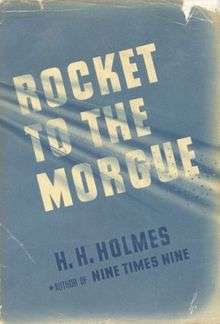Rocket to the Morgue

Rocket to the Morgue is a 1942 American locked room mystery novel by Anthony Boucher (originally published as by "H. H. Holmes", Boucher's frequent pseudonym when writing mysteries or writing about mysteries, and the pseudonym of a 19th-century American serial killer).
Plotline
Now-dead author Fowler Foulkes and his creation Dr. Derringer occupy a position in science fiction somewhat similar to that of Conan Doyle and Sherlock Holmes, or Edgar Rice Burroughs and Tarzan. The character has entered popular culture, and is known around the world, and the author's heir takes a fiercely protective and quite predatory view of the value of this heritage. (This dog-in-the-manger situation resembles the contemporary reports of the attitudes of Burroughs and of Doyle's heir[s].) Foulkes' son Hilary has made many enemies due to his inflexibility and greed. His niece Jenny lives in the Foulkes house and works as Hilary's private secretary, is devoted to him, but her fiance and his brother-in-law, D. Vance Wimpole (a science fiction writer), wants money (to pay off blackmailers); and he's recently had unpleasant encounters with two other local science fiction authors, Matt Duncan and Joe Henderson, at their expense. After two suspicious "accidents", Hilary suspects that his life is in danger, and asks for police help. Police Detective Inspector Terry Marshall (a casual acquaintance of Matt Duncan, who appeared in Nine Times Nine) arrives at the house just as a ticking "box of chocolates" is delivered.
The novel features two investigators from Boucher/Holmes' earlier locked door mystery Nine Times Nine: Sister Ursula of the convent of the fictitious Sisters of Martha of Bethany, and police detective Terence "Terry" Marshall. (Sister Ursula is the daughter of a policeman and had intended to become a policewoman herself before deciding that she had a higher calling to the religious life.)
Portrayal of science fiction culture in the Golden Age
Boucher was the friend and mentor of many science fiction writers of that era, and a member of the Mañana Literary Society. The dedication to the first edition reads, "For The Mañana Literary Society and in particular for Robert Heinlein and Cleve Cartmill." Rocket to the Morgue is something of a roman à clef about the Southern California science fiction scene of the time. Many characters are thinly-veiled versions of personalities such as Robert A. Heinlein ("Austin Carter"), L. Ron Hubbard ("D. Vance Wimpole"), then-literary agent Julius Schwartz ("M. Halstead Phynn") and rocket scientist/occultist/fan Jack Parsons ("Hugo Chantrelle"); or recognizable composites of two writers ("Matt Duncan" – Cleve Cartmill and Henry Kuttner; "Joe Henderson" – Jack Williamson and Edmond Hamilton). Some writers' actual pseudonyms appear as minor characters, most prominently "Don Stuart, editor of Surprising" (John W. Campbell, editor of Astounding Science Fiction); but also "Anson Macdonald", "Lyle Monroe" (both Heinlein pseudonyms)... and Anthony Boucher (whose real name was William Anthony Parker White)! The science fiction culture is portrayed in a familiar manner, complete with references to Denvention, the 1941 World Science Fiction Convention in Denver, and the appearance of a quintessential science fiction fan, one Arthur Waring, member of a science fiction society and publisher of a science fiction fanzine, whose sophisticated language and scientific knowledge displayed in a fan letter have impressed Detective Marshall, but who when interviewed turns out to be a pre-adolescent: "[a]n infant with pink and downy cheeks".
Publication history
The first edition was published in 1942 (as by "H. H. Holmes") by Duell, Sloan and Pearce. The first paperback edition in 1943 was the first and only book published under the imprint "A Phantom Mystery".[1] It has been repeatedly reprinted (after 1944, as by Anthony Boucher), beginning with a 1952 Dell edition.